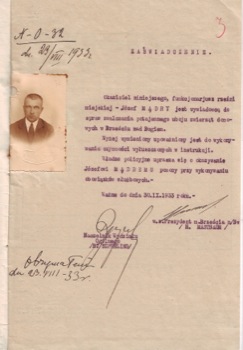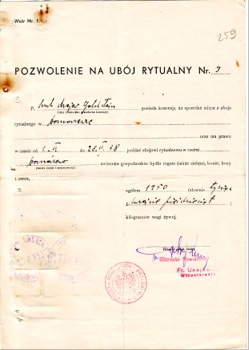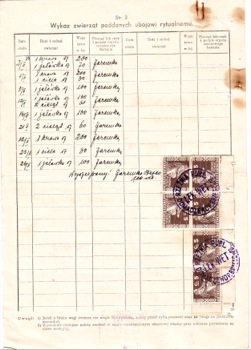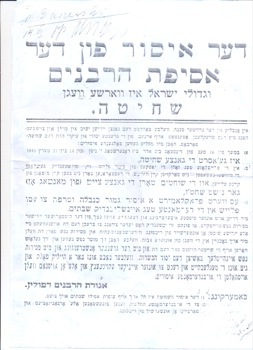Permission for Kosher Slaughtering
Meir (?) Goldshtein is granted a franchise to sell meat of ritual slaughtering. This franchise applies from the 1st to 28th of February 1938. He is permitted to bring to [Name of slaughter house and location] for ritual slaughtering, farm animals – horned cattle, (including calves), horses, goats and the like.
Total weight of live animals: [in numbers and words] 1250 KG
The ban declared by the assembly of Rabbis
And the prominent sages of Israel in Warsaw
Upon Shkhita
Because of the great danger that threatens the entire Jewish community in Poland, and in connection with the harsh attempt to erase of one of the greatest religious fundamentals [of Judaism] - forbidding
Shkhita, we have adopted a number of resolutions:
1. During 16 days - from 14 to 30 March 1939 - to cease all
shkhita.
2. During these meatless days, meat shops selling kosher meat must be completely closed. Delicatessen shops will not sell any sausages, the restaurants are forbidden to serve dishes made of any meat, and the
shokhtim [ritual slaughterers] are forbidden to perform any
shkhita at all [from Monday on].
3. We declare a total prohibition on eating meat and meat products – treating it as eating
Treyfa [non-kosher] - in the above-described days, including Saturday's meal.
We express our deep belief and conviction, based on historical Jewish readiness to self-sacrifice exactly as always: any attempt to force the Jews to break the laws of religion awakens resistance and self-sacrifice in all Jews --of all classes or inclinations-- to protect religion. So will we also follow in the footsteps of our ancestors, who sacrificed themselves to die at the stake for their religion and with the greatest strain and self-dedication united, to defend
Kashrut -- which is what makes us a holy people and provides us the possibility and the right to our eternal existence. So everybody without exception will abide by the above-described prohibitions.
The Association of the Rabbis of Poland
Notes:
1. The ban on
shkhita applies to poultry as well, even for celebrating the Sabbath.
2. All organizations and parties, regardless of inclinations, joined the above mentioned resolutions.





